#hci
Explore tagged Tumblr posts
Note
How does a person get involved with Hendry roleplay?
The HCI roleplay is definitely for people who are intensely into prison role play, chain gang role play, and really testing themselves.

There are two paths to signing up for HCI.
The first is exploring this type of play at Franklin County Historic Jail (also known as Hampton). This is a small group roleplay involving 2 to 5 inmates and usually 3 guards. It focuses on intake, restraints, uniforms, and basic roleplay.
www.hamptonjail.com or [email protected]
Once you have a 1, 2, or the recommended 3 day experience, simply ask about HCI. Most of the staff can help you.

The second route is to apply directly to HCI or, I can discuss it with you in a private chat. Unless you are someone who the management team knows or you come with a reference, it is rare for us to accept an applicant who is not vetted.
HCI roleplays can involve upwards of 35 participants over a 3 to 4 day period.
There is a registration platform on the Notion website.

Question about HCI Roleplay
80 notes
·
View notes
Text
Heroes, Gods, and the Invisible Narrator
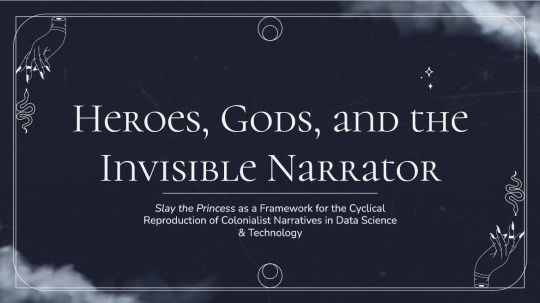
Slay the Princess as a Framework for the Cyclical Reproduction of Colonialist Narratives in Data Science & Technology
An Essay by FireflySummers
All images are captioned.
Content Warnings: Body Horror, Discussion of Racism and Colonialism
Spoilers for Slay the Princess (2023) by @abby-howard and Black Tabby Games.
If you enjoy this article, consider reading my guide to arguing against the use of AI image generators or the academic article it's based on.

Introduction: The Hero and the Princess
You're on a path in the woods, and at the end of that path is a cabin. And in the basement of that cabin is a Princess. You're here to slay her. If you don't, it will be the end of the world.
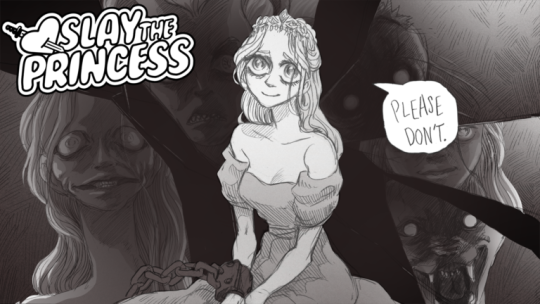
Slay the Princess is a 2023 indie horror game by Abby Howard and published through Black Tabby Games, with voice talent by Jonathan Sims (yes, that one) and Nichole Goodnight.
The game starts with you dropped without context in the middle of the woods. But that’s alright. The Narrator is here to guide you. You are the hero, you have your weapon, and you have a monster to slay.
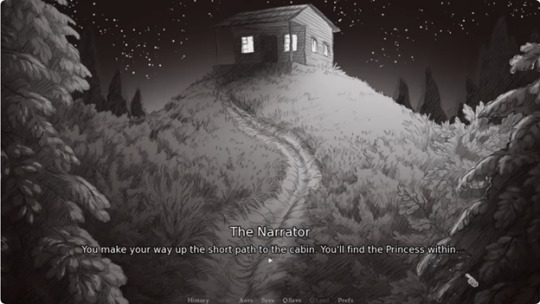

From there, it's the player's choice exactly how to proceed--whether that be listening to the voice of the narrator, or attempting to subvert him. You can kill her as instructed, or sit and chat, or even free her from her chains.
It doesn't matter.
Regardless of whether you are successful in your goal, you will inevitably (and often quite violently) die.
And then...
You are once again on a path in the woods.
The cycle repeats itself, the narrator seemingly none the wiser. But the woods are different, and so is the cabin. You're different, and worse... so is she.
Based on your actions in the previous loop, the princess has... changed. Distorted.


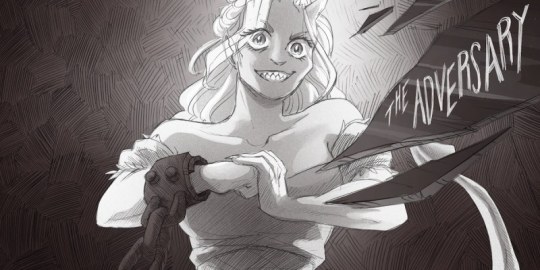
Had you attempted a daring rescue, she is now a damsel--sweet and submissive and already fallen in love with you.
Had you previously betrayed her, she has warped into something malicious and sinister, ready to repay your kindness in full.
But once again, it doesn't matter.
Because the no matter what you choose, no matter how the world around you contorts under the weight of repeated loops, it will always be you and the princess.

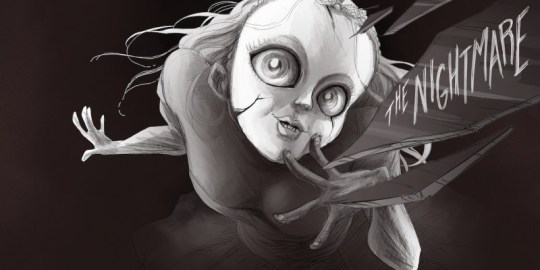
Why? Because that’s how the story goes.
So says the narrator.
So now that we've got that out of the way, let's talk about data.

Chapter I: Echoes and Shattered Mirrors
The problem with "data" is that we don't really think too much about it anymore. Or, at least, we think about it in the same abstract way we think about "a billion people." It's gotten so big, so seemingly impersonal that it's easy to forget that contemporary concept of "data" in the west is a phenomenon only a couple centuries old [1].
This modern conception of the word describes the ways that we translate the world into words and numbers that can then be categorized and analyzed. As such, data has a lot of practical uses, whether that be putting a rover on mars or tracking the outbreak of a viral contagion. However, this functionality makes it all too easy to overlook the fact that data itself is not neutral. It is gathered by people, sorted into categories designed by people, and interpreted by people. At every step, there are people involved, such that contemporary technology is embedded with systemic injustices, and not always by accident.
The reproduction of systems of oppression are most obvious from the margins. In his 2019 article As If, Ramon Amaro describes the Aspire Mirror (2016): a speculative design project by by Joy Buolamwini that contended with the fact that the standard facial recognition algorithm library had been trained almost exclusively on white faces. The simplest solution was to artificially lighten darker skin-tones for the algorithm to recognize, which Amaro uses to illustrate the way that technology is developed with an assumption of whiteness [2].
This observation applies across other intersections as well, such as trans identity [3], which has been colloquially dubbed "The Misgendering Machine" [4] for its insistence on classifying people into a strict gender binary based only on physical appearance.

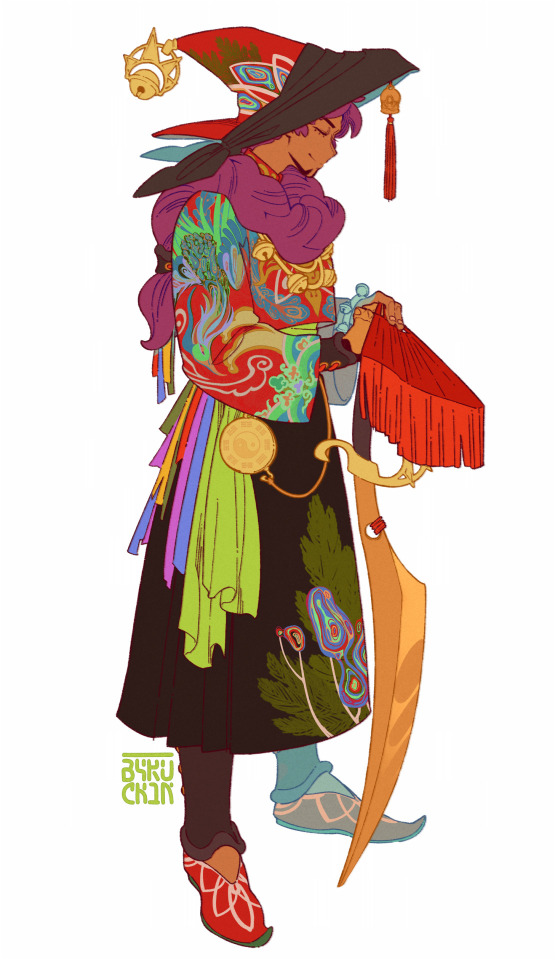

This has also popped up in my own research, brought to my attention by the artist @b4kuch1n who has spoken at length with me about the connection between their Vietnamese heritage and the clothing they design in their illustrative work [5]. They call out AI image generators for reinforcing colonialism by stripping art with significant personal and cultural meaning of their context and history, using them to produce a poor facsimile to sell to the highest bidder.
All this describes an iterative cycle which defines normalcy through a white, western lens, with a limited range of acceptable diversity. Within this cycle, AI feeds on data gathered under colonialist ideology, then producing an artifact that reinforces existing systemic bias. When this data is, in turn, once again fed to the machine, that bias becomes all the more severe, and the range of acceptability narrower [2, 6].

Luciana Parisi and Denise Ferreira da Silva touch on a similar point in their article Black Feminist Tools, Critique, and Techno-poethics but on a much broader scale. They call up the Greek myth of Prometheus, who was punished by the gods for his hubris for stealing fire to give to humanity. Parisi and Ferreira da Silva point to how this, and other parts of the “Western Cosmology” map to humanity’s relationship with technology [7].
However, while this story seems to celebrate the technological advancement of humanity, there are darker colonialist undertones. It frames the world in terms of the gods and man, the oppressor and the oppressed; but it provides no other way of being. So instead the story repeats itself, with so-called progress an inextricable part of these two classes of being. This doesn’t bode well for visions of the future, then–because surely, eventually, the oppressed will one day be the machines [7, 8].
It’s… depressing. But it’s only really true, if you assume that that’s the only way the story could go.
“Stories don't care who takes part in them. All that matters is that the story gets told, that the story repeats. Or, if you prefer to think of it like this: stories are a parasitical life form, warping lives in the service only of the story itself.” ― Terry Pratchett, Witches Abroad

Chapter II: The Invisible Narrator
So why does the narrator get to call the shots on how a story might go? Who even are they? What do they want? How much power do they actually have?
With the exception of first person writing, a lot of the time the narrator is invisible. This is different from an unreliable narrator. With an unreliable narrator, at some point the audience becomes aware of their presence in order for the story to function as intended. An invisible narrator is never meant to be seen.
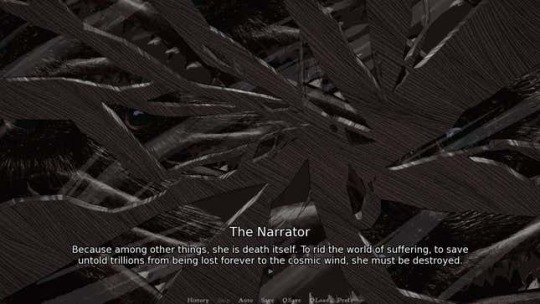
In Slay the Princess, the narrator would very much like to be invisible. Instead, he has been dragged out into the light, because you (and the inner voices you pick up along the way), are starting to argue with him. And he doesn’t like it.
Despite his claims that the princess will lie and cheat in order to escape, as the game progresses it’s clear that the narrator is every bit as manipulative–if not moreso, because he actually knows what’s going on. And, if the player tries to diverge from the path that he’s set before them, the correct path, then it rapidly becomes clear that he, at least to start, has the power to force that correct path.
While this is very much a narrative device, the act of calling attention to the narrator is important beyond that context.

The Hero’s Journey is the true monomyth, something to which all stories can be reduced. It doesn’t matter that the author, Joseph Campbell, was a raging misogynist whose framework flattened cultures and stories to fit a western lens [9, 10]. It was used in Star Wars, so clearly it’s a universal framework.
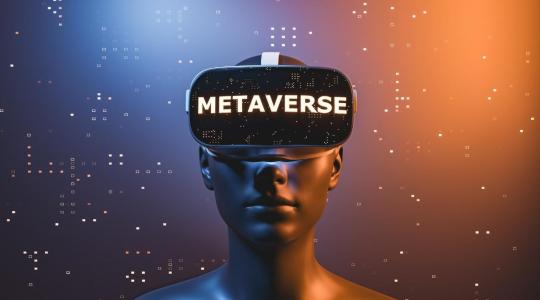


The metaverse will soon replace the real world and crypto is the future of currency! Never mind that the organizations pushing it are suspiciously pyramid shaped. Get on board or be left behind.
Generative AI is pushed as the next big thing. The harms it inflicts on creatives and the harmful stereotypes it perpetuates are just bugs in the system. Never mind that the evangelists for this technology speak over the concerns of marginalized people [5]. That’s a skill issue, you gotta keep up.
Computers will eventually, likely soon, advance so far as to replace humans altogether. The robot uprising is on the horizon [8].
Who perpetuates these stories? What do they have to gain?
Why is the only story for the future replications of unjust systems of power? Why must the hero always slay the monster?
Because so says the narrator. And so long as they are invisible, it is simple to assume that this is simply the way things are.

Chapter III: The End...?
This is the part where Slay the Princess starts feeling like a stretch, but I’ve already killed the horse so I might as well beat it until the end too.
Because what is the end result here?
According to the game… collapse. A recursive story whose biases narrow the scope of each iteration ultimately collapses in on itself. The princess becomes so sharp that she is nothing but blades to eviscerate you. The princess becomes so perfect a damsel that she is a caricature of the trope. The story whittles itself away to nothing. And then the cycle begins anew.

There’s no climactic final battle with the narrator. He created this box, set things in motion, but he is beyond the player’s reach to confront directly. The only way out is to become aware of the box itself, and the agenda of the narrator. It requires acknowledgement of the artificiality of the roles thrust upon you and the Princess, the false dichotomy of hero or villain.
Slay the Princess doesn’t actually provide an answer to what lies outside of the box, merely acknowledges it as a limit that can be overcome.

With regards to the less fanciful narratives that comprise our day-to-day lives, it’s difficult to see the boxes and dichotomies we’ve been forced into, let alone what might be beyond them. But if the limit placed is that there are no stories that can exist outside of capitalism, outside of colonialism, outside of rigid hierarchies and oppressive structures, then that limit can be broken [12].

Denouement: Doomed by the Narrative
Video games are an interesting artistic medium, due to their inherent interactivity. The commonly accepted mechanics of the medium, such as flavor text that provides in-game information and commentary, are an excellent example of an invisible narrator. Branching dialogue trees and multiple endings can help obscure this further, giving the player a sense of genuine agency… which provides an interesting opportunity to drag an invisible narrator into the light.
There are a number of games that have explored the power differential between the narrator and the player (The Stanley Parable, Little Misfortune, Undertale, Buddy.io, OneShot, etc…)
However, Slay the Princess works well here because it not only emphasizes the artificial limitations that the narrator sets on a story, but the way that these stories recursively loop in on themselves, reinforcing the fears and biases of previous iterations.
Critical data theory probably had nothing to do with the game’s development (Abby Howard if you're reading this, lmk). However, it works as a surprisingly cohesive framework for illustrating the ways that we can become ensnared by a narrative, and the importance of knowing who, exactly, is narrating the story. Although it is difficult or impossible to conceptualize what might exist beyond the artificial limits placed by even a well-intentioned narrator, calling attention to them and the box they’ve constructed is the first step in breaking out of this cycle.
“You can't go around building a better world for people. Only people can build a better world for people. Otherwise it's just a cage.” ― Terry Pratchett, Witches Abroad

Epilogue
If you've read this far, thank you for your time! This was an adaptation of my final presentation for a Critical Data Studies course. Truthfully, this course posed quite a challenge--I found the readings of philosophers such as Kant, Adorno, Foucault, etc... difficult to parse. More contemporary scholars were significantly more accessible. My only hope is that I haven't gravely misinterpreted the scholars and researchers whose work inspired this piece.
I honestly feel like this might have worked best as a video essay, but I don't know how to do those, and don't have the time to learn or the money to outsource.
Slay the Princess is available for purchase now on Steam.
Screencaps from ManBadassHero Let's Plays: [Part 1] [Part 2] [Part 3] [Part 4] [Part 5] [Part 6]
Post Dividers by @cafekitsune
Citations:
Rosenberg, D. (2018). Data as word. Historical Studies in the Natural Sciences, 48(5), 557-567.
Amaro, Ramon. (2019). As If. e-flux Architecture. Becoming Digital. https://www.e-flux.com/architecture/becoming-digital/248073/as-if/
What Ethical AI Really Means by PhilosophyTube
Keyes, O. (2018). The misgendering machines: Trans/HCI implications of automatic gender recognition. Proceedings of the ACM on human-computer interaction, 2(CSCW), 1-22.
Allred, A.M., Aragon, C. (2023). Art in the Machine: Value Misalignment and AI “Art”. In: Luo, Y. (eds) Cooperative Design, Visualization, and Engineering. CDVE 2023. Lecture Notes in Computer Science, vol 14166. Springer, Cham. https://doi.org/10.1007/978-3-031-43815-8_4
Amaro, R. (2019). Artificial Intelligence: warped, colorful forms and their unclear geometries.
Parisisi, L., Ferreira da Silva, D. Black Feminist Tools, Critique, and Techno-poethics. e-flux. Issue #123. https://www.e-flux.com/journal/123/436929/black-feminist-tools-critique-and-techno-poethics/
AI - Our Shiny New Robot King | Sophie from Mars by Sophie From Mars
Joseph Campbell and the Myth of the Monomyth | Part 1 by Maggie Mae Fish
Joseph Campbell and the N@zis | Part 2 by Maggie Mae Fish
How Barbie Cis-ified the Matrix by Jessie Gender
#slay the princess#stp spoilers#stp#stp princess#abby howard#black tabby games#academics#critical data studies#computer science#technology#hci#my academics#my writing#long post
245 notes
·
View notes
Text

daily drawing day 6
#daily drawing#my art#oc#original character#illustration#digital art#procreate#art#5/12/25#day 5#hci#my ocs#sage
6 notes
·
View notes
Text

Week 2, book 2. I definitely need to whip out my planner and get myself into gear. I did not plan my time well this week and ended up staying awake until 3AM meeting deadlines, which I have learned I am no longer built for as a 26 year old. C’est la vie I suppose. I’m still getting used to all of the reading grad school requires, especially considering my undergraduate degree was an art degree. I began college with a liberal arts graduate prep style program, but it has been a looooooong time since I used that part of my brain. Of course my minor was Anthropology, but ethnographic text is soooooo different than the standard academic format. But I can already feel myself reading quicker and more efficiently the more I push myself and my focus is improving, so hopefully it will get easier with time. But man does my gen-z mush brain just want to binge watch 90 Day Fiancé and doomscroll.
3 notes
·
View notes
Text
youtube
Didn’t read the paper, but seems like a good principle for interaction in general. Lamp looks so sad on Task 2 (2:03).
2 notes
·
View notes
Text
What Jane Austen Taught Me About Running Zoom Meetings
Many of our social interactions happen digital these days, even “face-to-face” ones like Zoom meetings. It’s still just not the same as in-person, whether for meetings, a book club, or just to hang out. There must be a better way to gather digitally. I think a big piece of why digital isn’t working is that we don’t have social norms there.
Social norms are what make a conversation flow smoothly. You see it in how close you stand or sit together, how you take turns, and in the type of space you choose. Basic videoconferencing has none of this: we can’t control distance, audio lags or mutes, and it’s almost always the same black screen of videos from job interviews to birthday parties.
Some tools try to mimic in-person social interactions and norms in digital meeting spaces, kind of like a video game. Each person has an avatar that moves around a digital space and hears nearby conversation. The word for directly recreating things or experiences into digital tools is skeuomorphism. It’s easy for people to learn because it’s just like the other familiar version. But it also can point out the ways that digital just can’t be the same as in-person. Making a videogame-like social event does bring some social norms into that digital conversation, but it also reminds us that we aren’t in person, we can’t shake hands, we look at the whole room like a map instead of from our eyes.
So digital doesn’t work and just mimicking in-person doesn’t make it all intuitively work. So I’m going to look for new social norms.
Actually, I’m going to look for really old ones.
~~~
Regency era England definitely had well-established social norms. Think Jane Austen’s books, like Pride and Prejudice, or Netflix’s Bridgerton. The middle and upper classes of that time easily knew what to expect from each other and what would be expected of them just from where they were and what was going on, thanks to social rules and etiquette. At least some of these social norms feel overly strict to a modern eye. And this is actually what I was looking for with digital social norms. Computer rules are also very, very strict (eventually it’s all 1s and 0s). They don’t give us wiggle room within the rules. In a lecture, you shouldn’t talk, but you can whisper to the friend next to you. But try whispering in a Zoom meeting while muted. So what can Jane Austen’s social norms give digital meeting spaces? I have 3 ideas to start.
~~~
1. Being a host is a social job, not tech support
The host of Regency ball had little in common with a Zoom host. On Zoom, hosting is muting and unmuting attendees, managing recording, and placing avatars in different rooms; tech support. Being a Regency host was social, they greeted each person on arrival, introduced them people they should know, and generally showed them what the ball had to offer. And this was before they entered the ball.


I think it would be nice to not just appear in a sea of black squares, not knowing who was there and not knowing if conversation had already started. Imagine a one-on-one greeting between you and an organizer who took you to a small group of peers and introduced you, or brought you to the full group after explaining that people are waiting for the actual book club to start but can join breakout rooms to chat in the meantime.
~~~
2. Dancing lets us get to know each other and the group

Don’t worry, I am not going to ask you to dance in Zoom. Like I said, I’m not here for skeuomorphism. But a major reason for dancing at balls (you know, besides it was fun) was a chance for two people to chat one-on-one and for the larger community to know who was chatting with who. Everyone saw who was dancing not just by looking at the dance floor, but also by looking at people’s dance cards (which they carried or hung on their wrist) and seeing whose name was written for each dance.

Hybrid teams struggle to get to know each other because they mostly communicate through text or in team meetings with little time for social chatting. Us remote workers miss having a space to just talk, not about work or anything in particular. We could make digital meeting spaces that use voice chat to let pairs of people quickly connect and talk, and use a digital dance card to let the group see who’s been chatting with who.
~~~
3. Candles set the stage and expectations
Little details at a Regency ball could give important cues to attendees. The length of the candles burning in the rooms would tell people how long the ball was expected to last and that told them what was available at the ball. Short candles? A few hours of dancing and some food. Long candles? Settle in for a long night and look for places to take a break with card games or other amusement.

Digital meetings spaces are entirely missing this. Zoom always looks the same! It doesn’t matter if I’m playing a game with my family or presenting a progress report. The skeuomorphism can help here to bring in the same cues we have in person; make the background a living room for game night or an office for the presentation. But sometimes that just reminds us that we’re not in a living room together and might make the video uncanny. I want digital meeting places to have décor cues that are all their own. Because digital meeting spaces are not just replacements for in person ones. They’re something new and I want us to really explore what we can do with them.

3 notes
·
View notes
Text
Gonna fire this baby up with the following post regarding #CHI2024, #whyCHI, and any other academic conference planning to remain in Hawai'i in this or any other year. May this discomfort lead us to new knowledge and renewed action.
#MauiSolidarity
3 notes
·
View notes
Text
VDO ký kết hợp tác chiến lược với xFusion, thúc đẩy toàn cầu hóa sản phẩm AI và công nghệ xanh
Tại Hội nghị cấp cao do Tập đoàn xFusion tổ chức, Công ty Cổ phần VDO và xFusion đã ký kết Biên bản ghi nhớ (MOU), đánh dấu bước ngoặt trong chiến lược mở rộng ra thị trường quốc tế của VDO. Thỏa thuận này thể hiện sự đồng thuận mạnh mẽ giữa hai bên trong việc thúc đẩy phát triển các giải pháp hạ tầng số và trí tuệ nhân tạo, hướng đến hợp tác lâu dài và bền vững...
Hội nghị quy tụ các lãnh đạo cấp cao đến từ khu vực Đông Nam Á, Hồng Kông và Macao, nhằm tăng cường kết nối và mở rộng mạng lưới hợp tác trong lĩnh vực công nghệ thông tin. Đáng chú ý, s��� kiện có sự hiện diện của ngài Vandia Yang - Chủ tịch Khu vực Đông Nam Á, kiêm Tổng giám đốc Văn phòng đại diện xFusion tại Hồng Kông, ông Chen Honglun - Giám đốc Kinh doanh Khu vực Đông Nam Á, ông Zheng Zhenlong - Giám đốc Kinh doanh Khu vực Việt Nam - Lào - Campuchia, và ông Phạm Văn Phúc - Giám đốc Phát triển Kinh doanh xFusion Việt Nam.
TỪ TRẢI NGHIỆM THỰC TIỄN ĐẾN NIỀM TIN HỢP TÁC DÀI HẠN
Trong thời gian công tác tại Trịnh Châu, đoàn đại diện VDO đã trực tiếp đến thăm và làm việc tại trụ sở chính cũng như trung tâm sản xuất công nghệ cao của xFusion. Tại đây, VDO được tìm hiểu mô hình vận hành khép kín của đối tác - nơi tích hợp chặt chẽ các hoạt động nghiên cứu, phát triển và sản xuất trên nền tảng công nghệ tiết kiệm năng lượng và thân thiện với môi trường.

Thông qua các buổi trao đổi chuyên sâu cùng ban lãnh đạo và đội ngũ chuyên gia xFusion, VDO đánh giá cao chiến lược phát triển hệ sinh thái công nghệ của đối tác từ GPU Server, AI Server cho đến các giải pháp hạ tầng siêu hội tụ (HCI) thế hệ mới. Những công đoạn kiểm thử nghiêm ngặt tại nhà máy cũng cho thấy mức độ sẵn sàng cao của các dòng sản phẩm mới, đáp ứng tốt nhu cầu ngày càng khắt khe của thị trường Việt Nam - nơi các doanh nghiệp đang đặt ra yêu cầu cao về hiệu suất, độ ổn định và khả năng triển khai linh hoạt.
Chuyến thăm không chỉ giúp hai bên làm rõ định hướng phát triển trong giai đoạn tới, mà còn củng cố nền tảng cho mối quan hệ hợp tác chiến lược lâu dài, niềm tin được xây dựng từ sự thấu hiểu và chia sẻ tầm nhìn phát triển bền vững.
BƯỚC NGOẶT TRONG CHIẾN LƯỢC TOÀN CẦU HÓA
Thỏa thuận hợp tác chiến lược giữa VDO và xFusion không chỉ tập trung vào việc OEM các dòng GPU Server thế hệ mới, hệ thống máy chủ phục vụ AI, HPC và Cloud riêng tư (Private Cloud), mà còn hướng đến việc đồng phát triển các giải pháp Trung tâm Dữ liệu xanh, Robot tự hành và các ứng dụng AI tiên tiến. Đây là bước đi chiến lược nhằm đáp ứng nhu cầu hạ tầng công nghệ ngày càng cao tại các thị trường mới nổi và toàn cầu.
Với vai trò là đối tác chiến lược, VDO không chỉ đơn thuần là nhà phân phối hay nhập khẩu, mà đang chuyển mình thành đơn vị đồng kiến tạo giải pháp từ thiết kế phần cứng, thử nghiệm hiệu năng đến thương mại hóa sản phẩm phù hợp với đặc thù từng thị trường bản địa.

HƯỚNG TỚI NỘI ĐỊA HÓA VÀ PHÁT TRIỂN BỀN VỮNG
Theo định hướng mới, VDO sẽ đầu tư vào trung tâm R&D và kiểm thử tại Việt Nam, hỗ trợ đánh giá hiệu năng thực tế và thúc đẩy quá trình nội địa hóa sản phẩm. Đây sẽ là nền tảng để tiến tới sản xuất các hệ thống máy chủ AI và giải pháp công nghệ xanh ngay tại thị trường trong nước, giảm phụ thuộc vào chuỗi cung ứng quốc tế và nâng cao tính chủ động của doanh nghiệp Việt.
Phát biểu tại sự kiện, ông Nguyễn Văn Minh - Chủ tịch HĐQT VDO nhấn mạnh: “Thỏa thuận này là minh chứng rõ nét cho cam kết của chúng tôi trong việc mở rộng quy mô ra thị trường quốc tế, đồng thời phát triển hạ tầng công nghệ xanh, thông minh và bền vững cho kỷ nguyên AI. Chúng tôi tin rằng, với sự đồng hành từ xFusion, VDO sẽ góp phần kiến tạo những giải pháp đột phá, đóng góp thiết thực vào tiến trình chuyển đổi số tại Việt Nam và khu vực.”
Với bước đi đầy quyết đoán này, VDO đang từng bước hiện thực hóa khát vọng vươn lên trở thành doanh nghiệp công nghệ hàng đầu Đông Nam Á, đồng thời đóng góp tích cực vào sự phát triển của hệ sinh thái hạ tầng số toàn cầu.
Trải qua hơn 16 năm phát triển, VDO đã khẳng định vị thế trong các lĩnh vực như phân phối hạ tầng công nghệ thông tin, điện toán đám mây, trung tâm dữ liệu, tích hợp hệ thống, bán lẻ và thương mại điện tử. Doanh nghiệp đang không ngừng mở rộng chuỗi giá trị, hướng tới sản xuất các sản phẩm công nghệ thông tin “Make in Vietnam”, đồng thời đẩy mạnh hiện diện tại thị trường trong nước và khu vực, đóng góp tích cực vào hệ sinh thái công nghệ xanh và bền vững.
xFusion là nhà cung cấp hạ tầng điện toán toàn cầu, có trụ sở tại Singapore, hoạt động với tầm nhìn “Để công nghệ điện toán phục vụ bạn tốt hơn”. Tập đoàn hiện sở hữu 9 trung tâm R&D, 7 văn phòng khu vực và 6 Trung tâm Hỗ trợ Kỹ thuật toàn cầu (GTACs), phục vụ hơn 10.000 khách hàng tại hơn 100 quốc gia và vùng lãnh thổ, bao gồm các lĩnh vực như viễn thông, tài chính, internet, giao thông và năng lượng. Trung tâm sản xuất toàn cầu của xFusion đặt tại Penang (Malaysia) với công suất lên tới 200.000 máy chủ mỗi năm, đóng vai trò then chốt trong việc bảo đảm chuỗi cung ứng linh hoạt và chất lượng tiêu chuẩn quốc tế.
0 notes
Text

if you’re wondering where I’ve been I’ve been stuck in figma hell
#academia#gradblr#hci#stemblr#coding#artists on tumblr#prototype#figma#figmadesign#computer#userexperience#ui ux design
0 notes
Text

daily drawing day 19
0 notes
Text
VMware Alternative Data Availability
For organizations considering a VMware exit, IT should consider VMware alternative data availability options, which are potentially more critical than lowering license fees. Over-focusing on cost can leave the organization’s data vulnerable. Effective data availability strategies guarantee continuous access to data, even during hardware failures, and minimize downtime, safeguarding productivity…

View On WordPress
0 notes
Text
Transforming Interaction: A Bold Journey into HCI & UX Innovations.
Sanjay Kumar Mohindroo Sanjay Kumar Mohindroo. skm.stayingalive.in Explore the future of Human-Computer Interaction and User Experience. Uncover trends in intuitive interfaces, gesture and voice control, and emerging brain-computer interfaces that spark discussion. #HCI #UX #IntuitiveDesign In a world where technology constantly redefines our daily routines, Human-Computer Interaction (HCI)…
#Accessibility#Adaptive Interfaces#Brain-Computer Interfaces#Ethical Design#Future Trends In UX#Gesture-Controlled Systems#HCI#Human-Computer Interaction#Innovative Interface Design#Intuitive Interfaces#Multimodal Interaction#News#Sanjay Kumar Mohindroo#Seamless Interaction#user experience#User-Centered Design#UX#Voice-Controlled Systems
0 notes
Text
The Human Capital Initiative (HCI) conference has officially launched in Riyadh.
The King Abdulaziz International Conference Center in Riyadh, Saudi Arabia, launched the second edition of the Human Capital Initiative (HCI) conference today, Sunday. This year’s theme is “Beyond Future Preparedness.” Global Participation and Key Events The conference attracts over 300 leaders, policymakers, and global experts from academia, the private sector, and non-profit organizations.…
0 notes
Photo
There is a large contingent of people on this website who have spent the last few weeks complaining about the concept of any ui redesign whatsoever, making the example of ao3 as the PERFECT website because it has not been significantly redesigned at all since its release. Now, I will willingly admit that redesign for its own sake is the enemy of usability.
However.
If a large part of a user base cannot find and/or make use of a feature, that's not on them (the same is true for the debate about dark/light mode a few years back - it doesn't matter if a custom skin exists, if it's not called "night mode" and sits in the header, footer, or a settings menu, it may as well not exist.) The fault isn't the user's. It is true that ao3 was an absolutely golden example of usability when it started (I'll link the video of that one talk if I find it) , but that was fourteen years ago. Its audience has grown, has changed. Standards for user patterns have changed. Clearly, the language and/or ui needs a revamp every so often to keep it current and we're seeing the fallout of that here. I don't know exactly what needs to be done, presumably some research, polling, and a/b testing

But it does.
39K notes
·
View notes
Text
Pinakastra Computing Private Limited
Founded in 2021 in Bangalore, Karnataka, India, Pinakastra Computing specializes in Private cloud infrastructure and hyperconverged infrastructure (HCI), offering innovative cloud solutions for enterprises, academia, and research organizations. Our Pinaka ZTi™ cloud platform integrates advanced hardware and software to deliver scalable, efficient, and secure private cloud solutions. Pinakastra aims to fill the gap in India’s enterprise tech ecosystem by offering alternatives to global cloud providers. We focus on addressing the growing demand for VM & Container based AI/ML workloads with modular, cost-efficient, and scalable solutions, aspiring to become a global leader in cloud infrastructure.
https://pinakastra.com/
#PrivateCloud#CloudComputing#IoT#DataSecurity#HyperConvergedInfrastructure#HCI#SecureData#HealthcareIT#FinTech#EdTech#biotech#GovernmentIT#ManufacturingTech#RetailSolutions#smartfactory
1 note
·
View note
